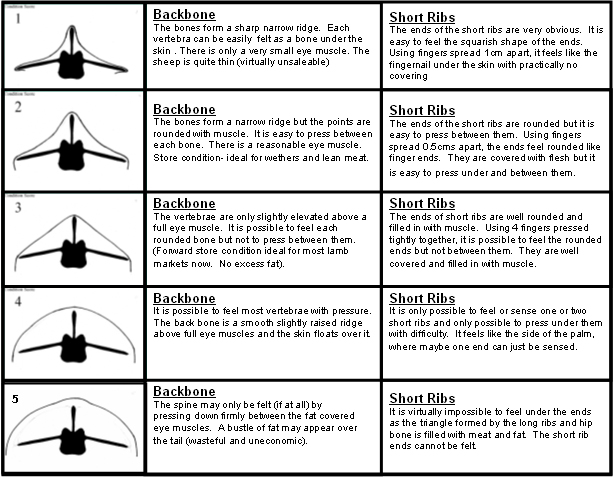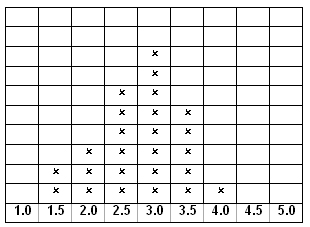|
Condition scoring sheep is an
easy and accurate method of
estimating the condition or
'nutritional well-being'
your sheep flock. It is
particularly useful for
monitoring pregnant and
lactating ewes. It requires
you to assess the amount of
tissue and fat covering the
backbone and the short ribs
of each sheep. Each
assessment should only take
a matter of seconds, and
condition scoring enough
sheep to get an assessment
of the mob will only take 20
minutes or so and can be
done while sheep are in for
other husbandry activities.
Condition scoring a mob twice
over a month can give a
reliable indication of
weight loss or gain. This is
useful, particularly in the
lead up to mating, as
condition at mating can have
a significant impact on
lambing percentage.
Condition scoring during the
dry period will give much
more accurate information on
how the flock is travelling
compared with pasture
assessment, as pasture
quantity and quality are
difficult to assess at this
time.
A random sample of 25 sheep
from the mob will give an
average condition score that
can then be used to make
decisions such as feed
budgeting.
Condition scoring is often
more useful than live weight
in that it;
- Doesn't rely on a weigh
crate being set up - can
be done anywhere a sheep
can be yarded
- Can be done without
having to correct for
wool growth or the
influence of wet wool on
live weight
- Needs no correction for
weight of the foetus in
pregnant ewes or the
weight of fluid during
lactation
- Can be used on a mob of
sheep with different
frame sizes
View the 'How
to condition score'
video on YouTube!
Click
here
Condition Score in Relation
to Fat Score
Many people are familiar with
fat scoring through the
marketing of prime lambs.
Prime lambs are often
assessed on fat score over
the last long rib at the GR
site 110 mm from the
backbone. Fat score is an
estimate of the total tissue
depth (fat + muscle). There
is a strong correlation
between condition score and
fat score measured as tissue
depth at the GR site (in mm)
but the relationship is not
linear. Fat score 2 (5
to 10 mm) covers the wide
range in condition score
from 2 to 3.5 (store to
greater than forward store).
Hence, when managing ewe
flocks we believe it is more
sensitive to use condition
score rather than fat score.
See
more detail and
conversion
guidelines.
How to
Condition Score
The animal should be standing
in a relaxed position. It
should not be tense, crushed
by other animals or held in
a crush. If the animal is
tense it is not possible to
feel the short ribs and get
an accurate condition score.
Place your thumb on the
backbone just behind the
last long rib and your
fingers against the stubby
ends of the short ribs. Use
the scoring system described
below to assign a score.
Many people use a system of
half scores such as 2, 2.5,
3, 3.5 etc.
Randomly draft 25 sheep into
a race or choose a random
group from the middle of the
mob. Many people choose a
couple of animals from each
race full when drenching or
doing some other animal
husbandry task. Be sure to
record the scores so that
you can calculate the
average. A simple method of
calculating the median of
the mob is to use the Condition
Score
worksheet. This not
only gives you a middle
point but also shows the
range of scores and whether
there is a significant tail
in the mob.
Condition
Score Description

Using
the Condition Score Yard
Book
Record the condition score of
each sheep with an 'X' on
the chart. The median score
of the mob is the score at
the middle of the
distribution (between the
12th and 13th cross when
counting from the left of
the score sheet) and in the
example below it is 3.0 (or
as an average it is 2.8).
Example:

A paper version
of this note book, suitable
for 4 mobs, is available
here: Print
Condition Scoring Yard
Book
A
double
sided
version
that
incorporates the
descriptions
and the blue
chart is
available to
download here.

|